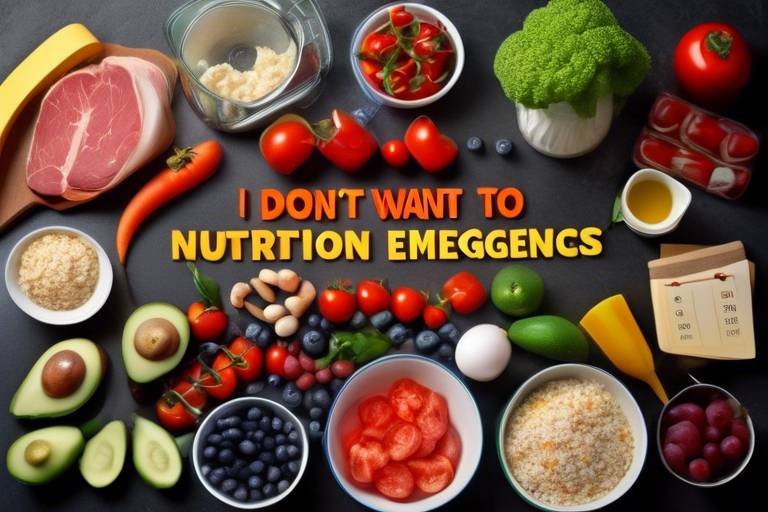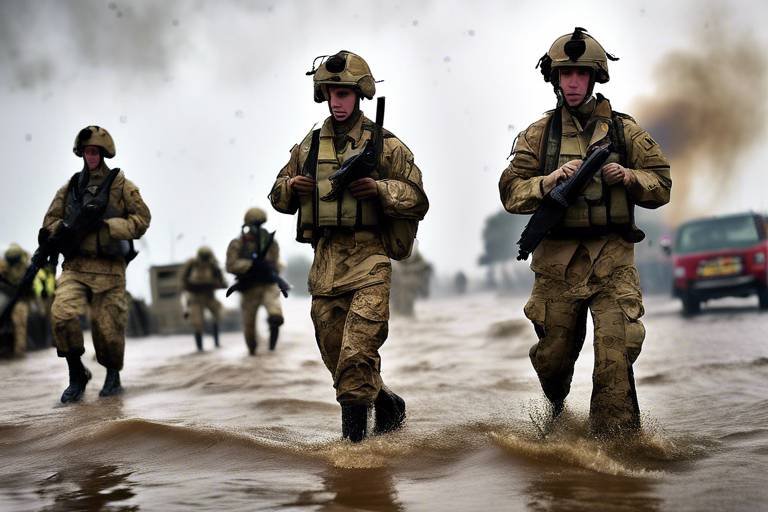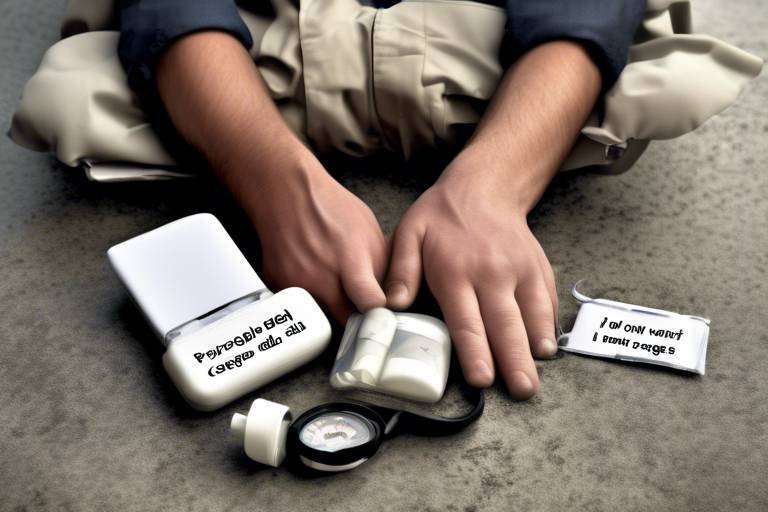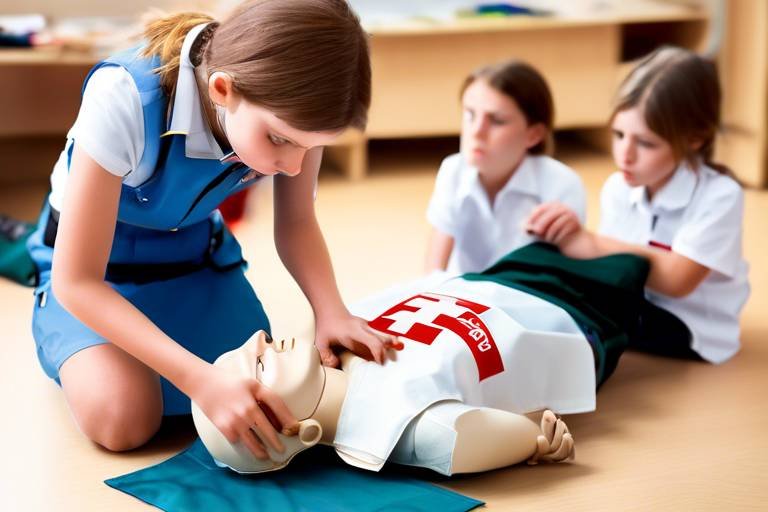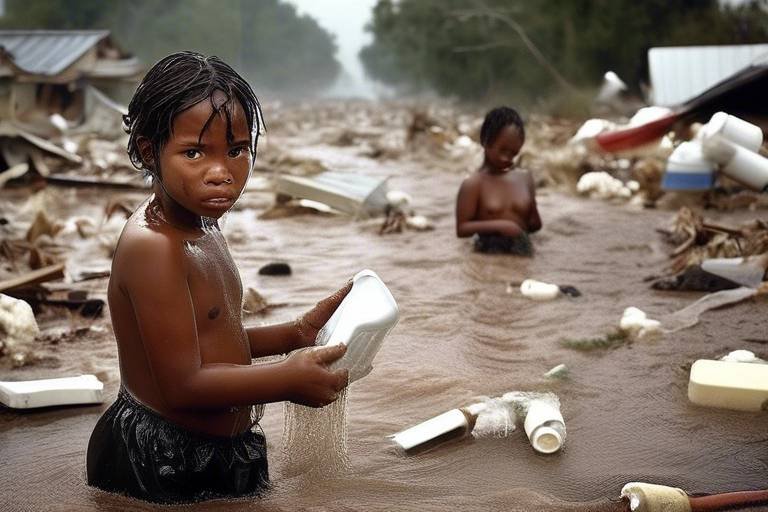Planning Nutrition during Emergencies
In times of crisis, whether it's a natural disaster, a pandemic, or any unexpected event, the importance of nutrition planning cannot be overstated. When the world turns upside down, our bodies still require the right fuel to function optimally. This article explores the significance of nutrition planning during emergencies, focusing on strategies that ensure proper dietary intake, food safety, and accessibility. After all, just as you wouldn’t drive a car without fuel, you shouldn’t navigate a crisis without a solid nutritional plan in place.
Imagine facing a situation where food supplies become scarce or access to fresh produce is limited. How do you ensure that you and your loved ones maintain a balanced diet? The key lies in preparation. By understanding your nutritional needs and having a well-thought-out plan, you can enhance your resilience and health during challenging times. This article will guide you through the essential aspects of planning nutrition during emergencies, ensuring that you are equipped to handle whatever comes your way.
First and foremost, it’s essential to recognize that different populations have varying nutritional requirements. For instance, children, pregnant women, the elderly, and those with chronic health conditions all have specific dietary needs that must be addressed, especially in crisis situations. This understanding is crucial because neglecting these needs can lead to serious health issues, further complicating an already difficult situation. As we delve into this topic, we’ll explore how age, health status, and activity levels influence dietary needs in emergencies.
Moreover, effective food supply strategies play a vital role in ensuring that you have the right foods available when disaster strikes. This includes stockpiling non-perishable items, utilizing community resources, and striving for a balanced diet to meet your nutritional needs. It’s not just about having food; it’s about having the right kind of food that can sustain you and your family during tough times. From canned goods to dried fruits, knowing what to include in your emergency food supply can make all the difference.
As you prepare for emergencies, remember that nutrition is not just about survival; it’s about maintaining health and well-being. In the sections that follow, we will dive deeper into understanding nutritional needs, effective food supply strategies, and food safety practices to ensure that you are ready for any unforeseen circumstances. Let’s embark on this journey of preparedness together, ensuring that we not only survive but thrive, even in the face of adversity.
- What are the essential nutrients to consider during emergencies? It's important to focus on proteins, carbohydrates, fats, vitamins, and minerals to ensure a balanced diet.
- How can I prepare my family for potential food shortages? Stockpiling non-perishable items and having a plan for community resources can be very effective.
- What are some safe food storage techniques during emergencies? Keeping food in a cool, dry place and using airtight containers can help maintain its quality.

Understanding Nutritional Needs
When it comes to emergencies, understanding the specific nutritional needs of different populations is absolutely crucial. Imagine a scenario where access to food is limited—what would your body require to stay strong and healthy? This understanding goes beyond just filling your stomach; it involves recognizing how factors such as age, health status, and activity levels can dramatically influence dietary requirements during crises.
For instance, consider the elderly. Their bodies often have unique nutritional needs due to slower metabolism and potential chronic health issues. They may require more vitamins and minerals to support their immune systems and overall health. On the other hand, children, who are still growing, need a balanced intake of proteins, carbohydrates, and fats to fuel their development. It’s a bit like tuning a musical instrument; each age group requires a different note to create harmony in their health.
Moreover, individuals with pre-existing health conditions, such as diabetes or heart disease, have specific dietary restrictions that must be adhered to, especially in stressful situations. For example, someone with diabetes must monitor their carbohydrate intake carefully, even during emergencies, to avoid dangerous spikes in blood sugar levels. It’s not just about survival; it’s about maintaining a quality of life.
Activity levels also play a significant role in determining nutritional needs. A person engaged in physically demanding work, like a first responder or a volunteer during a disaster, will require more calories and nutrients compared to someone who is less active. This principle can be likened to a car: the more you drive it, the more fuel it needs to keep running smoothly. Therefore, understanding these varying needs is essential in ensuring that everyone has access to the right kinds of food during emergencies.
As we delve deeper into the intricacies of nutrition in crisis situations, it’s important to remember that not all foods are created equal. A well-rounded diet that includes a variety of food groups can help maintain energy levels and support recovery. In the next sections, we’ll explore practical strategies for emergency food supply planning, ensuring that everyone—regardless of their unique nutritional needs—can weather the storm.

Emergency Food Supply Strategies
When it comes to emergencies, having a solid food supply strategy can make all the difference. Imagine being caught in a natural disaster or facing an unexpected crisis without access to essential nutrition. It’s not just about surviving; it’s about thriving even in tough times. Planning your food supply means you can maintain your health and well-being, which is crucial for staying resilient. So, how do you go about ensuring you have the right foods on hand? Let’s dive into some effective strategies for emergency food supply.
First and foremost, stockpiling non-perishable items is essential. These are foods that have a long shelf life and can withstand various environmental conditions. Think of items like canned goods, dried grains, and packaged meals. Not only do they provide essential nutrients, but they also require minimal preparation, which is a significant advantage when time is of the essence. However, it’s not just about quantity; quality matters too. A well-balanced diet should be your goal, even in emergencies. This means including a variety of food groups in your stockpile.
To help you get started, here’s a quick look at some key categories of non-perishable foods you should consider:
- Grains: Rice, pasta, and oats are excellent sources of carbohydrates that provide energy.
- Proteins: Canned beans, nuts, and dried meats are vital for muscle repair and overall health.
- Dairy Alternatives: Powdered milk or shelf-stable plant-based milk can help meet calcium needs.
- Fruits and Vegetables: Look for canned or dehydrated options to ensure you get your vitamins.
Utilizing community resources can also enhance your emergency food supply strategy. Local food banks and community gardens can be invaluable during times of crisis. They not only provide access to nutritious foods but also foster a sense of community and support. Collaborating with neighbors can lead to shared resources, making it easier to stock up on essential items. Imagine pooling together with friends and family to create a larger food supply; this not only lightens the load but also ensures a more varied diet.
Moreover, planning for food accessibility is crucial. In times of crisis, transportation might be limited, so consider how you will access your stockpiled food. Keep your supplies in a location that is easy to reach, and make sure to have a plan for how you will transport food if necessary. It’s also wise to rotate your stock; consume the older items first to prevent waste. Regularly check expiration dates and replenish your supplies as needed.
In summary, effective emergency food supply strategies revolve around understanding your nutritional needs, stockpiling wisely, leveraging community resources, and ensuring accessibility. By taking these steps, you’ll not only be prepared for emergencies but also maintain your health and resilience when it matters most.
Q: How much food should I stockpile for emergencies?
A: It depends on your household size and dietary needs. A good rule of thumb is to have at least a three-day supply of food for each person in your household.
Q: What are the best non-perishable foods to include?
A: Focus on a variety of food groups, including grains, proteins, fruits, and vegetables. Canned goods, dried beans, rice, and nuts are excellent choices.
Q: How can I ensure my food stays safe during an emergency?
A: Store food in a cool, dry place, and keep it sealed in airtight containers to prevent spoilage. Regularly check your supplies for expiration dates and rotate them as needed.
Q: What community resources are available for food during emergencies?
A: Local food banks, community gardens, and cooperative food programs can provide essential nutrition during crises. Connecting with neighbors can also lead to shared resources.

Identifying Non-Perishable Foods
When it comes to preparing for emergencies, one of the smartest moves you can make is to stock up on non-perishable foods. These are foods that can be stored for extended periods without spoiling, making them essential for any emergency food supply. Think of them as your culinary superheroes, always ready to save the day when fresh options are scarce. But what exactly qualifies as a non-perishable food? Let's dive into the essentials!
Non-perishable foods come in various forms, each offering unique benefits. For instance, canned goods are a staple in many households. They are not only convenient but also retain their nutritional value for years. When choosing canned items, look for low-sodium options to keep your heart healthy. Additionally, dried foods like beans, lentils, and grains are excellent choices, providing a solid source of protein and fiber. These items can be cooked easily and are versatile enough to fit into various meals.
To help you better understand the types of non-perishable foods to consider, here's a quick overview of categories you should focus on:
| Food Category | Examples | Nutritional Benefits |
|---|---|---|
| Canned Goods | Vegetables, fruits, soups | Rich in vitamins and minerals |
| Grains | Rice, pasta, quinoa | Good source of carbohydrates |
| Protein Sources | Canned beans, nuts, dried meats | Essential for muscle repair and energy |
| Dehydrated Foods | Fruits, vegetables, meals | Lightweight and nutrient-dense |
It’s important to note that while non-perishable foods can last a long time, they still require some consideration regarding storage conditions. Keep them in a cool, dry place to maximize their shelf life. Regularly check expiration dates, and rotate your stock to ensure you're consuming the oldest items first. This way, you’ll always have a fresh supply ready for any situation.
In conclusion, identifying and stocking up on non-perishable foods is a crucial step in emergency preparedness. By focusing on a variety of items, including canned goods, grains, protein sources, and dehydrated foods, you can create a balanced and nutritious food supply that will keep you and your loved ones nourished during tough times. Remember, having the right non-perishable foods on hand is not just about survival; it’s about ensuring you maintain a healthy diet even when the unexpected happens.

Protein Sources
When it comes to maintaining health during emergencies, protein plays a crucial role. It’s the building block of our body, helping to repair tissues, build muscles, and support immune function. During a crisis, ensuring an adequate intake of protein can be challenging, but it’s essential for overall well-being. So, what are some reliable protein sources that can be stored for emergencies? Let’s dive into the world of non-perishable protein options!
First up, we have canned beans. These little powerhouses are not only rich in protein but also packed with fiber, making them a great choice for keeping you full and satisfied. A single can of black beans contains about 15 grams of protein, which is fantastic for a quick meal. Plus, they have a long shelf life, so you can stock up without worrying about spoilage. You can toss them into soups, salads, or even mash them up for a tasty dip.
Next on the list are nuts and seeds. Almonds, walnuts, and sunflower seeds are excellent sources of protein that also provide healthy fats. A handful of nuts can pack in around 6-8 grams of protein, depending on the type. They’re perfect for snacking, and their versatility means you can add them to a variety of dishes or enjoy them on their own. Just remember to store them in airtight containers to keep them fresh!
For those who prefer something heartier, consider dried meats, such as beef jerky or turkey jerky. These are not only high in protein but also easy to carry and consume on the go. A typical serving of jerky can contain up to 10 grams of protein, making it a convenient option for emergency kits. Just be mindful of the sodium content, as some brands can be quite salty.
Lastly, let’s not forget about powdered protein supplements. These can be an incredibly versatile addition to your emergency food supply. Whether it’s whey, soy, or pea protein, these powders can easily be mixed into smoothies, oatmeal, or even baked goods. They offer a concentrated source of protein, often providing around 20-30 grams per serving. Just make sure to store them in a cool, dry place to maintain their quality.
In summary, having a variety of protein sources in your emergency food supply can significantly enhance your nutritional intake during a crisis. From canned beans to nuts, dried meats, and protein powders, these options not only provide the necessary protein but also add flavor and variety to your meals. Always remember to check expiration dates and rotate your supplies regularly to ensure freshness. After all, being prepared is about more than just having food; it’s about having the right food to keep you healthy and strong!

Fruits and Vegetables
When it comes to maintaining a balanced diet during emergencies, play an indispensable role. They are not only vital sources of essential vitamins and minerals but also provide necessary fiber that helps in digestion and overall health. However, fresh produce can be hard to come by in times of crisis, which is why having a stock of dehydrated and canned options is crucial. These alternatives can offer the same nutritional benefits as fresh produce, making them a smart choice for any emergency food supply.
Dehydrated fruits and vegetables retain most of their nutrients and have an incredibly long shelf life. For instance, dehydrated apples or carrots can be easily rehydrated in water and used in meals, providing a burst of flavor and nutrition. On the other hand, canned fruits and vegetables are often packed with preservatives to maintain their freshness, making them another excellent option. When selecting canned goods, it's wise to choose those that are low in added sugars or sodium to ensure you're not compromising your health during an already challenging time.
Here are a few examples of nutrient-dense options to consider when planning your emergency food supply:
- Canned Spinach: Rich in iron and vitamins A and C, it can enhance the nutritional value of any meal.
- Dehydrated Peas: High in protein and fiber, they can be a great addition to soups and stews.
- Dried Fruits: Options like apricots and raisins are energy-dense and can satisfy sweet cravings while providing essential nutrients.
Moreover, incorporating a variety of colors in your food choices can help ensure a range of nutrients. Think of it as creating a color palette for your meals; the more colorful your plate, the wider the array of vitamins and minerals you’re likely to consume. For example, red bell peppers are packed with vitamin C, while purple eggplants offer antioxidants that can bolster your immune system.
In summary, while fresh fruits and vegetables may be hard to find during emergencies, having a stock of dehydrated and canned options can significantly contribute to your nutritional needs. By being proactive and planning ahead, you can ensure that your body gets the essential nutrients it requires, even in the most challenging circumstances.
Q: How long can dehydrated fruits and vegetables last?
A: Dehydrated fruits and vegetables can last anywhere from 5 to 30 years if stored properly in a cool, dry place. Always check for signs of spoilage before consumption.
Q: Are canned fruits and vegetables as nutritious as fresh ones?
A: While fresh produce is often the healthiest option, canned fruits and vegetables can still be nutritious. Look for options without added sugars or excessive sodium for the best health benefits.
Q: How can I incorporate dehydrated fruits and vegetables into my meals?
A: Dehydrated fruits and vegetables can be rehydrated by soaking them in water or adding them directly to soups, stews, and casseroles. They can also be blended into smoothies for added nutrition.

Community Resources for Nutrition
During emergencies, accessing nutritious food can be a significant challenge, but community resources can play a pivotal role in bridging the gap. Think of your community as a safety net, ready to catch you when times get tough. Local organizations, food banks, and community initiatives often mobilize quickly to provide essential support. They not only distribute food but also offer valuable resources and education on nutrition, helping individuals and families make informed choices even in dire circumstances.
One of the primary resources available is food banks. These establishments are usually stocked with non-perishable items and can provide families with a substantial amount of food during emergencies. They often collaborate with local grocery stores and farms to gather surplus food, ensuring that nothing goes to waste. Many food banks also offer fresh produce, which is vital for maintaining a balanced diet. It's like having a mini grocery store right in your neighborhood, where you can find what you need without having to worry about costs.
In addition to food banks, community gardens have been gaining popularity as a sustainable way to enhance food security. These gardens are often cultivated collectively by community members, providing fresh fruits and vegetables to those involved. Not only do they offer access to nutritious food, but they also foster a sense of community and belonging. Imagine planting seeds together, nurturing them, and then harvesting the fruits of your labor—all while building friendships and support networks. Community gardens can be especially beneficial in emergencies, as they provide a local source of food that is less reliant on external supply chains.
Moreover, many communities organize collaborative efforts to ensure that everyone has access to nutritious food. This can include meal distribution programs, cooking classes, and nutrition workshops. These initiatives often focus on teaching families how to prepare healthy meals with limited resources, emphasizing the importance of nutrition even when options are scarce. Think of it as a crash course in survival cooking, where you learn to whip up delicious and nutritious meals from what you have on hand.
To further illustrate the impact of these resources, consider the following table that highlights various community nutrition support systems:
| Resource Type | Description | Benefits |
|---|---|---|
| Food Banks | Organizations that collect and distribute food to those in need. | Access to a variety of non-perishable and fresh foods. |
| Community Gardens | Shared spaces where community members grow fruits and vegetables. | Fresh produce, community bonding, and educational opportunities. |
| Collaborative Programs | Initiatives that provide meals and nutrition education. | Skill-building in cooking and meal preparation. |
In conclusion, leveraging community resources can significantly enhance nutritional support during emergencies. By tapping into local food banks, participating in community gardens, and engaging in collaborative programs, individuals can ensure that they and their families have access to the nutrition they need to weather the storm. Remember, during tough times, you are not alone; your community is there to help you thrive.
Q: How can I find a local food bank?
A: You can search online for food banks in your area or contact local community centers for information.
Q: Are community gardens open to everyone?
A: Many community gardens welcome new members. Check with local gardening organizations to find one near you.
Q: What types of food are typically available at food banks?
A: Food banks usually provide non-perishable items, canned goods, and sometimes fresh produce.
Q: How can I get involved with community nutrition programs?
A: Look for local organizations that offer volunteer opportunities or programs focused on nutrition and food security.

Food Safety in Emergencies
When disaster strikes, the last thing anyone wants to worry about is whether their food is safe to eat. Food safety during emergencies is critical, not just for survival but for maintaining health and well-being. Imagine being in a situation where you have limited resources and you can't afford to get sick due to foodborne illnesses. That's why understanding how to handle, store, and prepare food safely during crises is essential.
First and foremost, it’s vital to maintain proper food handling practices. In emergencies, the risk of contamination increases significantly due to limited access to clean water and sanitation facilities. Always wash your hands with soap and safe water before handling food. If soap isn’t available, using hand sanitizer can be a temporary solution. Consider this: your hands are like the gatekeepers to your health. If they’re not clean, they can usher in all sorts of unwanted guests—bacteria and viruses that can wreak havoc on your body.
Next, let’s talk about food storage techniques. Proper storage is key to preventing spoilage and ensuring that your food remains safe to eat. Here are some guidelines:
- Keep food in airtight containers to protect it from pests and moisture.
- Store perishables in a cool, dark place, ideally below 40°F (4°C).
- Label stored food with the date it was packaged or opened, so you can keep track of its freshness.
In emergency situations, you may not have access to refrigeration, so consider investing in coolers or ice packs if you know a crisis is coming. Think of your food storage as a fortress; the better you protect it, the longer it will last.
Another crucial aspect is keeping track of expiration dates. Non-perishable foods can last a long time, but they do have a shelf life. Regularly check your supplies and rotate them, using the older items first. This practice is known as FIFO—first in, first out. It’s a simple yet effective strategy that can save you from unpleasant surprises when you reach for that can of beans.
Hygiene practices cannot be overstated. When preparing food, especially in a crisis, it’s essential to keep your work area clean. Use clean utensils and surfaces, and avoid cross-contamination by using separate cutting boards for raw meats and vegetables. This is akin to building a wall between your food and potential contaminants. If you wouldn’t want to eat dirt, don’t let it touch your food!
Finally, always be aware of signs of spoilage. If food looks or smells off, it’s better to err on the side of caution and throw it away. Trust your senses; they are your best allies in identifying potentially hazardous food. Remember, just because it’s in your pantry doesn’t mean it’s safe to consume. It’s like finding a treasure chest; sometimes, what’s inside isn’t worth the risk!
Q: How long can food last without refrigeration?
A: Generally, perishable foods should not be left out for more than two hours at room temperature. Non-perishable foods can last much longer, but always check expiration dates.
Q: What should I do if I suspect my food has spoiled?
A: If you suspect food has spoiled, it’s best to discard it. Eating spoiled food can lead to foodborne illnesses, which can be especially dangerous in emergencies.
Q: How can I ensure my water supply is safe during an emergency?
A: Always store water in clean, food-grade containers. If you're unsure about the safety of your water, boil it for at least one minute or use water purification tablets.
In conclusion, food safety during emergencies is not just about survival; it’s about maintaining your health and well-being. By following proper handling, storage, and hygiene practices, you can protect yourself and your loved ones from foodborne illnesses, ensuring that you can weather any storm that comes your way.

Safe Food Storage Techniques
When it comes to food storage during emergencies, understanding the right techniques can make all the difference between a safe meal and a potential health hazard. In a crisis, the last thing you want to worry about is whether your food is still safe to eat. So, let’s dive into some essential tips that will help you keep your food fresh and nutritious.
First and foremost, temperature control is crucial. Most perishable foods need to be stored in a cool environment to prevent spoilage. Ideally, your refrigerator should be kept at or below 40°F (4°C), while your freezer should be at 0°F (-18°C). If the power goes out, keep the refrigerator door closed as much as possible. A full fridge will keep food safe for about 4 hours, while a full freezer can maintain its temperature for 48 hours (24 hours if half-full). This is why it’s wise to have a few ice packs or bags of ice on hand, as they can help keep your food cold longer.
Another key point is the use of airtight containers. Investing in quality containers can protect your food from moisture and pests. For dry goods like grains, beans, and cereals, use containers made of glass or heavy-duty plastic with tight-fitting lids. This not only extends shelf life but also keeps your pantry organized. You can also label your containers with the date of storage, so you can easily track freshness.
For foods that are prone to spoilage, such as dairy products and meats, consider using vacuum sealing. This method removes air from the packaging, significantly reducing the chances of spoilage. Vacuum-sealed items can last much longer than those stored in traditional packaging. If you don’t have a vacuum sealer, you can use resealable plastic bags; just squeeze out as much air as possible before sealing.
Moreover, keeping your food storage area clean is essential. Regularly check for expired items and dispose of them to avoid contamination. A clean space not only helps in maintaining food safety but also makes it easier to find what you need in an emergency. Remember to wash your hands before handling food and ensure that all surfaces and utensils are sanitized.
Finally, it’s beneficial to have a food inventory. Keeping track of what you have stored can help you utilize older items before they expire, reducing waste and ensuring you always have access to safe, nutritious food. You can create a simple table or a digital list to keep everything organized.
| Food Type | Storage Method | Shelf Life |
|---|---|---|
| Canned Vegetables | Cool, dry place | 2-5 years |
| Dried Beans | Airtight container | 2-3 years |
| Frozen Meats | Freezer | 6-12 months |
| Dehydrated Fruits | Airtight container | 1 year |
By following these safe food storage techniques, you can ensure that your emergency food supplies remain safe and nutritious. It’s all about being proactive and prepared, which can make a huge difference in maintaining your health during challenging times.
- How long can food last without refrigeration? Generally, perishable foods can last about 2 hours at room temperature, while non-perishable foods can last indefinitely if stored properly.
- Can I refreeze food that has thawed? Yes, if the food is still cold (below 40°F), you can refreeze it, but the quality may suffer.
- What’s the best way to store water during emergencies? Use clean, food-grade containers and store them in a cool, dark place. Make sure to rotate your water supply every six months.

Hygiene Practices
When it comes to emergency situations, maintaining proper hygiene practices is not just a good idea—it's a necessity. In the chaos of a crisis, it can be all too easy to overlook the basics of food safety, but doing so can lead to serious health risks. Imagine you’ve managed to stockpile a decent amount of food, only to fall ill due to improper handling. That’s a scenario no one wants to face! So, let’s dive into some essential hygiene practices that can help keep you and your loved ones safe.
First and foremost, always wash your hands! It sounds simple, but it’s one of the most effective ways to prevent the spread of germs. Wash your hands with soap and clean water for at least 20 seconds before and after handling food. If soap and water aren’t available, use hand sanitizer that contains at least 60% alcohol. Remember, clean hands are your first line of defense against foodborne illnesses.
Next, ensure that all surfaces and utensils are clean. Before preparing any food, wipe down counters, cutting boards, and knives with a disinfectant. This is especially crucial when you’re working with raw foods, as they can harbor bacteria that contaminate other foods. You wouldn’t want to mix your fresh veggies with the bacteria from raw meat, right? To make things easier, consider creating a cleaning schedule that outlines when and how to clean your food prep areas. Consistency is key!
Another important aspect of hygiene is the proper storage of food. During emergencies, you might be tempted to stockpile food items without considering how to store them safely. Use airtight containers to keep pests out and to maintain the freshness of your food. Additionally, be mindful of the expiration dates on your supplies. A quick glance at a table like the one below can help you keep track of your food items:
| Food Item | Shelf Life | Storage Tips |
|---|---|---|
| Canned Beans | 2-5 years | Store in a cool, dry place |
| Dehydrated Fruits | 1-2 years | Airtight containers away from light |
| Rice | Indefinite (if stored properly) | Keep in a sealed container |
Moreover, when preparing food, it's essential to separate raw foods from cooked foods. This prevents cross-contamination, which is a leading cause of foodborne illness. Use different cutting boards for raw meats and vegetables, and always wash them in hot, soapy water after use. If you’re in a situation where resources are limited, consider using disposable plates and utensils to minimize the risk of contamination.
Lastly, don’t forget about the importance of cooking food to the right temperature. Use a food thermometer to ensure that your meals are cooked thoroughly. For instance, poultry should reach an internal temperature of 165°F (75°C) to be safe for consumption. This step is vital, especially when dealing with canned or dehydrated foods that may require rehydration or cooking.
In conclusion, practicing good hygiene in emergency situations can significantly reduce the risk of foodborne illnesses. By washing your hands regularly, keeping surfaces clean, storing food properly, separating raw and cooked items, and cooking food to the right temperatures, you can ensure that you and your family stay healthy during a crisis. Remember, a little effort goes a long way in safeguarding your health!
- What are the main hygiene practices to follow during emergencies? Always wash your hands, clean surfaces and utensils, store food properly, separate raw and cooked foods, and cook food to safe temperatures.
- How can I keep track of my food supplies? Create a list of your food items along with their expiration dates and storage tips, and update it regularly.
- What should I do if I suspect food contamination? Discard any suspicious food items and clean the area thoroughly to prevent further contamination.
Frequently Asked Questions
- Why is nutrition planning important during emergencies?
Nutrition planning during emergencies is crucial because it ensures that individuals have access to the necessary nutrients that support health and resilience. In times of crisis, stress levels can rise, and maintaining a balanced diet can help mitigate the physical and mental toll of the situation.
- What are some key nutritional needs for different populations during emergencies?
Different populations have varying nutritional needs. For instance, children require adequate calories and nutrients for growth, while elderly individuals may need softer foods and higher protein for muscle maintenance. Pregnant and breastfeeding women have increased caloric and nutrient needs to support both their health and that of their babies.
- What types of foods should I stockpile for emergencies?
When stockpiling food for emergencies, focus on non-perishable items such as canned goods, dried fruits, nuts, and grains. These foods not only have a long shelf life but also provide essential nutrients. Make sure to include a variety of protein sources, fruits, and vegetables to maintain a balanced diet.
- How can I ensure food safety during an emergency?
To ensure food safety during an emergency, practice proper food storage techniques, such as keeping perishable items at safe temperatures and using airtight containers. It's also important to maintain hygiene by washing hands and surfaces before food preparation to prevent foodborne illnesses.
- What are some effective safe food storage techniques?
Effective safe food storage techniques include keeping your refrigerator at or below 40°F (4°C), using separate containers for raw and cooked foods, and regularly checking expiration dates. For long-term storage, consider vacuum sealing items to extend their shelf life.
- How can community resources help during a nutritional crisis?
Community resources such as food banks, community gardens, and local organizations can provide vital support during nutritional crises. They often offer access to fresh produce, non-perishable food items, and nutritional education, helping to ensure that everyone has the necessary food to maintain their health.
- What hygiene practices should I follow during food preparation in emergencies?
Key hygiene practices during food preparation include washing hands thoroughly with soap and water, using clean utensils and surfaces, and avoiding cross-contamination by keeping raw and cooked foods separate. These practices help minimize the risk of foodborne illnesses during emergencies.

